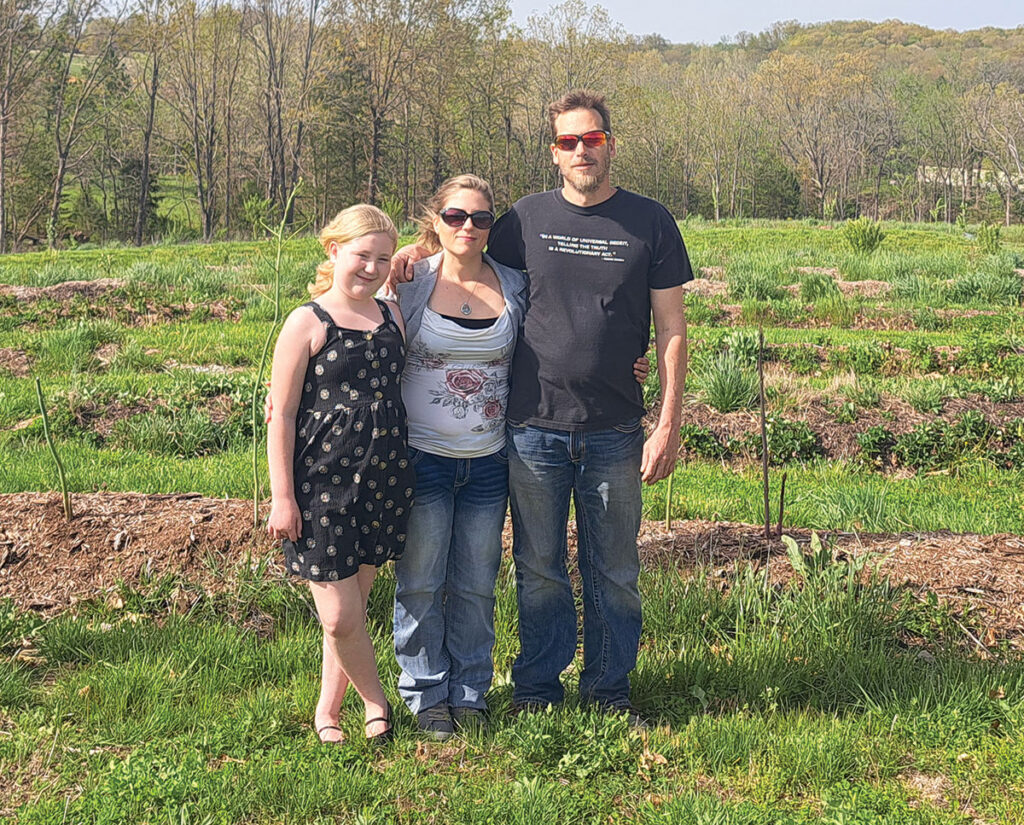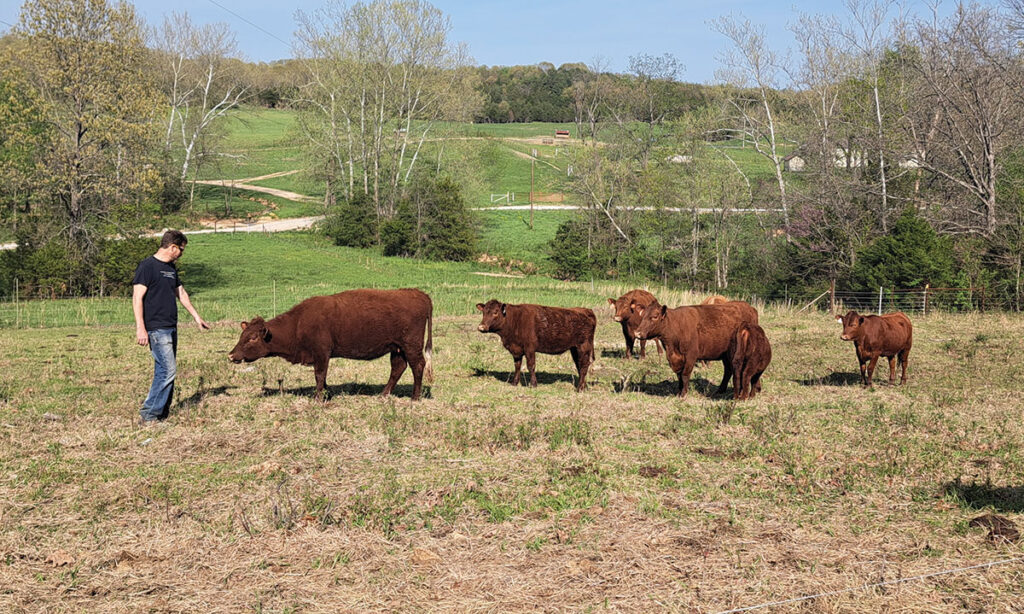
Nate and Brittany Gellman follow a methodical and scientific approach at their farm
MOUNTAIN GROVE, MO. – Nate and Brittany Gellman shared a vision of raising crops and animals through permaculture practices.
Their common interests led to the establishment of Happy Critters Farm & Orchard, LLC. Together with their daughter Emily, the Gellmans moved to Mountain Grove, Mo., in Douglas County in 2018.
“I had an eye on this part of the country for a long time. If you want to farm, there’s a reasonable amount of precipitation,” Nate said. He also liked the affordability of the land, wanting space to sustainably raise cattle with frequent rotation. They got enough land for their herd, currently consisting of 12 Red Devons and South Polls, and to plant an orchard with a variety of trees such as apples and pears.
Brittany, who studied molecular biology and home-schooled 12-year-old Emily, said she liked the home-schooling freedoms in Missouri and “wanted to come to a state with more freedom minded individuals.” In the beginning, while Nate was on the road for work, Brittany home-schooled and handled a lot of the farming on her own.
“Having him gone was a trial,” she said.
“It was a big struggle for her to try and deal with all of my ambitions,” Nate said. He was traveling for work as a pipeline rehab NDE (non-destructive evaluation) technician. “I did that for a little over 10 years. I’m still supporting that, but now I have an opportunity to work from home. I do QAQC (quality assurance quality control) review of field reports, support technician training, and assist management in various ways. It’s only been in the last year that I’ve been able to be home.”
Brittany said her education helped with “the systems thinking, being methodical and the scientific method.” Permaculture and regenerative farming drew her interest even more after becoming a mother and looking into pharmaceuticals when her daughter had digestive issues as an infant. Brittany has learned quite a bit since they started farming. “If you’re watching the grass and watching the cows, really, that’s how you learn the most.”
“I wasn’t looking for a specific breed. I was looking for a grass-fed genetic. Then it came down to finding seedstock as local as possible,” Nate said of their cattle.
The Red Devons came from a local farm.
“There’s no grain. We’re all grass,” he explained. “With the whole regenerative style and rotational grazing, the long-term goal is to get to a point where we have such good conditions that we can just supplement a little bit of hay here and there, but to have them on green, cool-season stockpile through the whole winter.”
Getting the land in shape has been their mission.
“We’re already seeing some improvements in our pasture. It doesn’t happen fast, but over time it really starts to compound in how much difference it makes,” Nate said. They focused on having diversity in their fields without spraying or using chemicals. Brittany said Nate moves the cattle every one to three days, “so they aren’t part of that parasitic life cycle. They’re eating off of new, fresh ground.”
“The biggest compromise I make is in the hay. I do my best to source stuff that hasn’t been sprayed or fertilized. The first year we fed hay, it was certified organic. I get the best that I can. It’s different every year,” said Nate. Brittany is equally committed to their natural methods. “I think that what we’re doing is the best for the planet and the people; for our health and the cows. For the piece of land that we are on, it’s an honorable thing. It may not be as profitable, though.”

“We want to continue to improve our genetics because every piece of land is different. Over five or 10 years, they are going to be epigenetically adapting to how we graze them,” Nate said.
The cattle have sea salt and kelp for minerals, which Nate said is “the most well-rounded.” They don’t use AI but have a bull and are linebreeding their herd.
“I’m trying to raise a grass-finished product, and at the same time, we’re trying to improve the genetics, and we’re small,” he explained.
“We want to get to a place where we can have the cows on fresh grass as much of the year as possible. I’m going to keep it [the herd] at about 14 total. That’s where I plan my top end, four mommas and then all their calves coming up and maybe replace the mommas here and there. I’m not going to look at going past that until I feel like we really have the soil and the pasture built up. We don’t want to over-impact our land. It doesn’t help the cows or the pasture. It really starts with the soil.”
Beef customers can select a whole or a half for their freezer from the Happy Critters website (happycrittersfarm.com). The Little Farm Store in Seymour, Mo., carries individual cuts of Happy Critters Farm & Orchard, LLC beef. Customers may order through the Little Farm Store website (littlefarmstore.com), and delivery is available in some areas.
In addition to improving pastures and developing their cattle herd, the Gellmans have worked to create an orchard. They put in a pond that is connected to a swale system, with concentric semicircles that catch rainwater, helping to sustainably keep the trees and plants going. Water can also come from the pond through an underground pipe system that’s gravity fed. It also supplies tire tanks for livestock. Nate’s long-term goal is to have apple and pear trees in production within three to four years. They also planted other trees such as peach, plum, pawpaw and persimmon.
“We’ll have a pole shelter, a farm store out there to be able to sell our meat when people are here to pick,” Nate said. Last year they had a variety of vegetables and fruits, including strawberries, blueberries, raspberries, blackberries, Nanking cherries, quince, cranberry, mayhaw, sour cherries and asparagus, to name some.
“I have a separate set of interests than he does. I envision this being more of an agritourism destination with educational classes expanding into mushrooms or herbs or a nursery. There are just so many different avenues that we can take that it’s really going to be dialing down our personal interests and what we’re passionate about next and able to take on and have the time for,” Brittany said of the future. They have chickens and a smaller garden where they are experimenting with growing different vegetables.
The farm is about 100 acres, with 30 of it in pastureland for the time being. Looking toward the future, Nate said, “I did want to look at other enterprises. Someday, I want to do forest run hogs.”
They are also interested in ducks and geese.
One area of the orchard is planted with ornamental flowers and pollinator-friendly plants, including milkweed and herbs such as lovage and marshmallow.
“The intent was to make it more about a relaxing space to come hang out, bring your kids, they can play on the little treehouse,” Brittany added. “People just need a space where they can relax and be in nature, an immersive, relaxing experience.”







